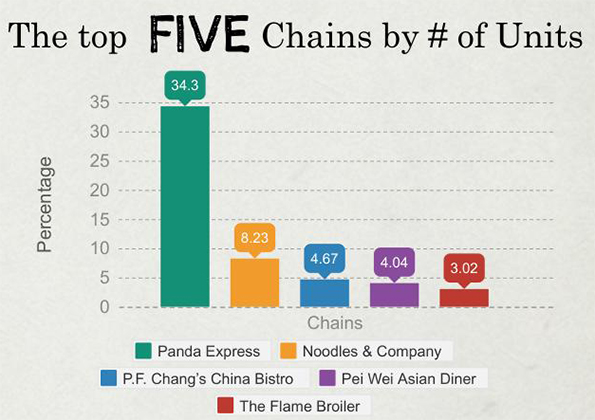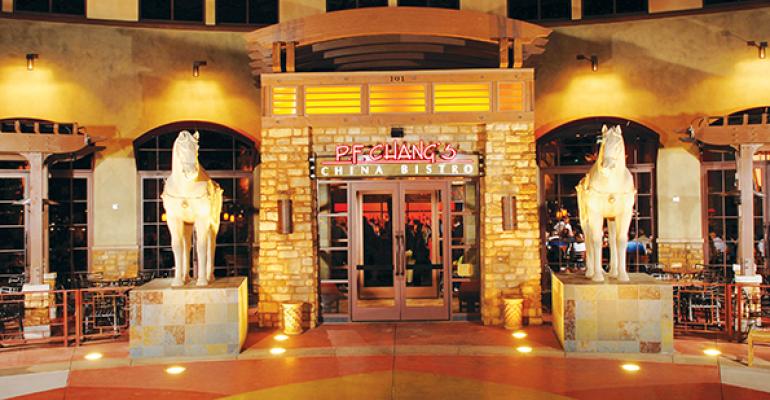Fast-casual concept gurus take note. Now there’s yet another reason why a chain restaurant that serves Asian food should be a can’t-miss proposition: lack of competition from other chains. Numbers compiled by foodservice database and analytics firm CHD Expert show that of the more than 64,000 Asian restaurants now doing business in the U.S., only six percent are run by chains.
Factor in the many other attributes this segment holds and you’d think fast casual developers would be opening new Asian concepts as fast as they could think them up. That’s not the case, even though this segment provides most of the things customers want from a contemporary restaurant experience. Consider: Asian food embraces a wide variety of unique ethnic flavors; most dishes are inherently healthful; the nature of Asian meal preparation makes it easy for patrons to customize their orders without overburdening the kitchen; and Asian dishes travel well, a particularly important component given the current boom in takeout and delivery business. All this and relatively low price points, too.
Restaurant industry watcher Technomic sees more growth on the way. “There's something about Asia,” Technomic writes in its roundup of 2015 food trends. “Asian foods have been trending for years, but the world's biggest and fastest-moving continent always delivers something new. In 2015, look for the breakout of Korean, mainstreaming of Vietnamese and upscaling of spicy ramen noodles, the quintessential Asian street food.”
There’s a lot going on in the Asian restaurant segment, even though CHD Expert’s data shows that most operators in it take the old-school approach. Not only is this segment heavily dominated by mom-and-pop operations. It’s also a stronghold of full-service operations. The numbers show that 84 percent of Asian restaurants in the U.S. are full-service.

Overall, Chicago-based CHD Expert found that “Asian” is the third most-popular menu type in the U.S, accounting for 9.75 percent of the national restaurant count. Included under the umbrella “Asian” term in this analysis are restaurants that serve Chinese, Japanese, Thai, sushi, Indian/Pakistani/Bangaladeshi/Sri Lankan, Vietnamese and Korean food. There’s also a catch-all “Other Asian” category that includes restaurants that offer food from Cambodia, Malaysia and Indonesia.
Collectively, these restaurants gross roughly $25 billion a year. It makes the Asian restaurant segment seem like a segment ripe for disruption by savvy fast casual operators. But where are the chains?
The relative handful that have given the Asian restaurant business a try do well. Four of the five largest Asian restaurant chains are fast-casual operations. CHD Expert ranks Panda Express as the largest player, with its 1,747 stores accounting for 34 percent of the Asian chain market. Next in line are Noodles & Company, full-service P.F. Chang’s China Bistro, Pei Wei Asian Diner and 170-unit Flame Broiler. Average unit volumes in these chains are significantly larger than the all-category average of $400,000. These concepts are still adding units, so the growth potential is there.
Yet the new fast-casual chains entering this segment are doing so at a measured pace. Chipotle Mexican Grill’s ShopHouse sells rice and noodle bowls at its ShopHouse Southeast Asian kitchen concept. It’s designed to be the company’s next avenue of growth. The first ShopHouse opened in 2011. But four years later, there are only nine units in operation, even though the parent company has unmatched expertise in building out a fast-casual concept in a hurry.
Yum! Brands can drive concept development at a rapid pace, too. But its fast-casual Banh Shop concept has just two units so far. One is in Dallas, the other is located at the Dallas-Fort Worth Airport. Interestingly, Yum! is focusing on banh mi sandwiches, which were on the original ShopHouse menu but subsequently removed.
There’s plenty of room for chains to maneuver in this widespread segment. But the lack of fast-casual development may reflect the simple fact that old-school Asian restaurants, while lacking fast-casual service speed and glitz, are darn tough competitors.
““The American restaurant landscape is always evolving, and once-foreign foods are becoming more commonplace than ever before,” says CHD Expert North America’s Brad Bloom. “Asian flavors are about as diverse as the restaurant landscape itself. The Asian Menu Type is varied, and while that can be exciting, it can also be difficult to navigate.” Amen.





